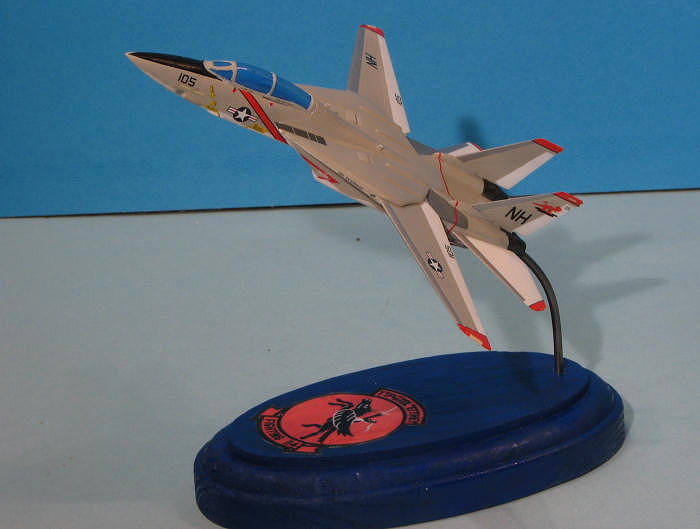
LS 1/144 F-14A Tomcat
| KIT #: | A 114 |
| PRICE: | I believe I paid $1.00 when new |
| DECALS: | One option |
| REVIEWER: | Scott Van Aken |
| NOTES: |

| HISTORY |
Hope you aren't too disappointed by the lack of a long historical background on the Tomcat, but it is fairly well known. Instead, here is some info on VF-114 during the Tomcat Era.
VF-114 was formed in early 1945 with Hellcats and then Corsairs as VBF-19. It later was changed to VF-114 and participated in the Korean war with Corsairs. Post war it flew Panthers, Banshees, Demons and the Phantom II before moving on to the Tomcat.
On 15 December 1975, VF-114 transitioned to the F-14 Tomcat along with their sister squadron, the VF-213 "Black Lions." This transition took a little more than a year and in October 1977 the squadron deployed with their F-14s for the first time, once again to the Western Pacific on the Kitty Hawk with CVW-11 and their sister squadron VF-213.
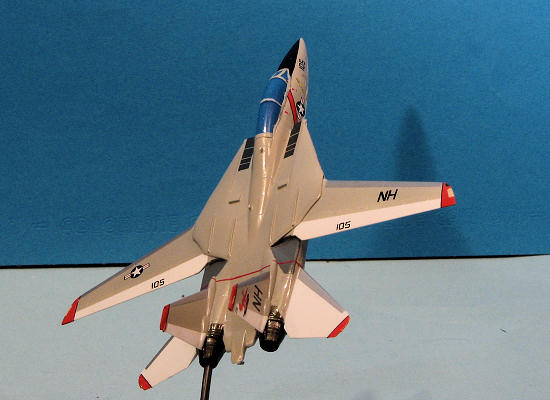 In March 1979, CVW-11 deployed aboard the USS America (CV-66) in a Mediterranean cruise, which was something of an oddity for a west coast-based carrier air wing, and a second cruise followed in 1981. On both these deployments VF-114 captured the Golden Tailhook award, which is given to the squadron that has the highest landing score for a cruise. VF-114 also won the west coast “High Noon” aerial gunnery competition and the "Mutha" trophy in 1982, which signified them as the best Pacific Fleet squadron. After their two Mediterranean cruises, VF-114 returned to the Pacific Fleet in September 1982 aboard the USS Enterprise (CVN-65). During this cruise, VF-114 participated in one of the largest naval exercises since World War II when it joined up with the carrier groups of USS Midway (CV-41) and USS Coral Sea (CV-43) in the Northern Pacific for two weeks. After their return to NAS Miramar, VF-114 once again won the “High Noon” and "Mutha" trophies, the first time that an F-14 squadron had won both these awards two years in a row.
In March 1979, CVW-11 deployed aboard the USS America (CV-66) in a Mediterranean cruise, which was something of an oddity for a west coast-based carrier air wing, and a second cruise followed in 1981. On both these deployments VF-114 captured the Golden Tailhook award, which is given to the squadron that has the highest landing score for a cruise. VF-114 also won the west coast “High Noon” aerial gunnery competition and the "Mutha" trophy in 1982, which signified them as the best Pacific Fleet squadron. After their two Mediterranean cruises, VF-114 returned to the Pacific Fleet in September 1982 aboard the USS Enterprise (CVN-65). During this cruise, VF-114 participated in one of the largest naval exercises since World War II when it joined up with the carrier groups of USS Midway (CV-41) and USS Coral Sea (CV-43) in the Northern Pacific for two weeks. After their return to NAS Miramar, VF-114 once again won the “High Noon” and "Mutha" trophies, the first time that an F-14 squadron had won both these awards two years in a row.
The squadron returned to sea on May 30, 1984 and returned home on December 20. During the cruise, the squadron and the air wing participated in several exercises, such as the "Rim of the Pacific (RIMPAC) exercise off of Hawaii and exercise Beacon Flash in the northern Philippines. Once again, the Aardvarks took part in yet another Fleet exercise in the Northern Pacific, this time with the carriers USS Midway (CV-41) and USS Carl Vinson (CVN-70).
In 1985, VF-114 conducted its Inter-Deployment Training Cycle (IDTC) at NAS Miramar in preparation for their next overseas deployment. During this period, in addition to regular at sea periods in the Southern California (SOCAL) Operational Area, the squadron also conducted extensive air combat training against other Navy squadrons as well as various USAF fighter and USMC fighter attack squadrons. On 24 January 1986, the squadron's next overseas deployment began aboard USS Enterprise (CVN-65) and they ventured out to the Western Pacific, which included stops at Pearl Harbor and Subic Bay in the Philippines. Continuing into the Indian Ocean, VF-114 often intercepted and shadowed Soviet and Indian aircraft. During this time, with operations against Libya by the National Command Authority taking center stage, the decision was made to move the Enterprise carrier battle group to the Mediterranean Sea. To do this, the battle group transited through the Suez Canal, making Enterprise the first nuclear powered aircraft carrier to do so. Upon arrival in the Gulf of Sidra and in the vicinity of the “Line of Death”, so named by Libyan strongman Muammar al-Gaddafi, CVW-11 fighter and strike fighter aircraft flew combat air patrols for two months, although  encounters with Libyan aircraft were rare. The carrier group made subsequent port visits to Naples and Toulon, and instead of returning through the Suez Canal, transited through the Strait of Gibraltar into the Atlantic, and then past the southern cape of Africa before continuing onto Perth, Australia for another port visit before continuing across the Pacific to its home port of San Diego.
encounters with Libyan aircraft were rare. The carrier group made subsequent port visits to Naples and Toulon, and instead of returning through the Suez Canal, transited through the Strait of Gibraltar into the Atlantic, and then past the southern cape of Africa before continuing onto Perth, Australia for another port visit before continuing across the Pacific to its home port of San Diego.
1987 was devoted to training which included deployments to NAF El Centro, California and NAS Fallon, Nevada. VF-114 again won the "Mutha" trophy and also the Naval Air Force Pacific Fleet Battle “E” battle efficiency award as the top F-14 squadron in the Pacific Fleet. In January 1988, the squadron's next cruise began, a portion of which was spent in the Persian Gulf escorting reflagged tankers through March, April and May due to the ongoing tanker war. In April 1988, VF-114 participated in Operation Praying Mantis. By February 1989, the carrier had returned to port and VF-114 began a compressed turnaround schedule, due to their next cruise beginning in September 1989. Even with the restricted time period, VF-114 was able to fit in significant training, deploying to NAF El Centro for FFARP (Fleet Fighter ACM Readiness Program) and as part of the air wing to NAS Fallon. Once on board the Enterprise, an around-the-world cruise began as the battle group took part in exercises around the globe concurrent with the Enterprise's transfer from the Pacific Fleet to the Atlantic Fleet and new homeport in Norfolk, Virginia. October saw VF-114 set a new flight record for an F-14 squadron, logging more than 811 hours in a single month. The end of this cruise saw the end of CVW-11's long attachment to the USS Enterprise, for their next cruise was to be on the Pacific Fleet's newest carrier, the USS Abraham Lincoln (CVN-72).
VF-114 arrived on board the Abraham Lincoln on September 25, 1990, while she was making her maiden voyage from Norfolk to Alameda, due to become her new home. The trip took six weeks and saw the carrier cruise round the tip of South America, 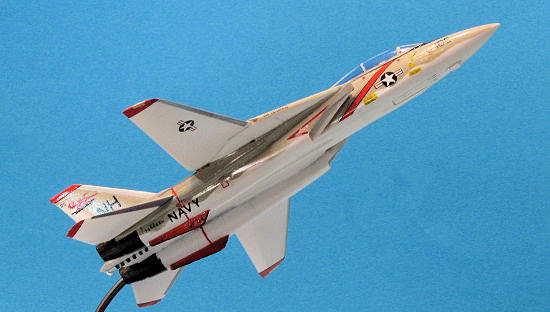 arriving at her new home in late November 1990. The first long-term deployment on Lincoln began in the middle of 1991, during the early part of the cruise the carrier and air wing were involved in the evacuation of thousands of military personnel and dependents from the Philippine Islands in the wake of the Mt. Pinatubo eruption. Once this was complete the Lincoln headed for the Persian Gulf.
arriving at her new home in late November 1990. The first long-term deployment on Lincoln began in the middle of 1991, during the early part of the cruise the carrier and air wing were involved in the evacuation of thousands of military personnel and dependents from the Philippine Islands in the wake of the Mt. Pinatubo eruption. Once this was complete the Lincoln headed for the Persian Gulf.
Although the initial plans had been for the Lincoln to be among the first relief carriers for those involved in Operation 'Desert Storm', by the time of her arrival the conflict was over and VF-114, along with the rest of CVW-11, was redirected to conduct post-ceasefire combat air patrols. The Aardvarks flew many hours over a burning Kuwait, seeing first hand the astounding landscape created by thousands of burning oil wells.
Like almost half of the F-14 community following Operation 'Desert Storm', VF-114 was disestablished as part of post-Cold War reductions in Naval Aviation. VF-114 was officially disestablished in a final ceremony at NAS Miramar on 30 April 1993.
| THE KIT |
This is pretty simple stuff, really. I know it has been superceded in terms of detail by both Dragon and Revell in this scale, but unlike those kits, this one is a lot more simple in terms of construction.
As you'd imagine from something 30 years old, it isn't the most detailed kit in the world. However, it does have engraved panel lines and that is pretty crisply done. Of course, this simplicity extends to the total lack of a cockpit, and no wheel well detail. It is 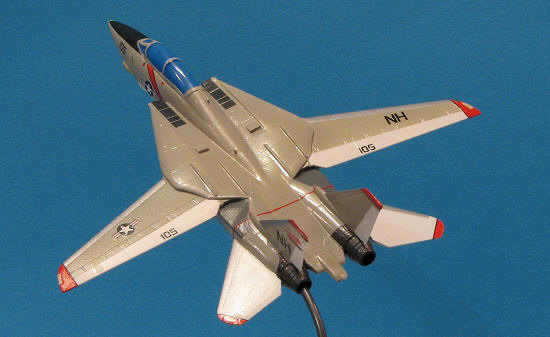 also missing drop tanks and wing pylons. It does have four Sparrow-like missiles, but they are not really well done as the tips of the fins are rather clipped.
also missing drop tanks and wing pylons. It does have four Sparrow-like missiles, but they are not really well done as the tips of the fins are rather clipped.
Swing wing plane models are supposed to have moveable wings and this one complies with that. There is no compressor detail at the end of the intakes; just blanks. Landing gear is simplified, but adequate for the scale and the price. The kit comes with a clear one piece canopy, but with nothing to see, perhaps one should be painting this one blue. Landing gear doors are build for in flight so must be cut if displaying the model on its gear.
The instructions are printed on the inside of the box top and are quite adequate. No color information aside from the overall shades of light gull grey over white are given. The small decal sheet is for a VF-2 plane, but you'll have to paint all the red, white, blue and yellow bits you see on the box art. You'll also have to scrounge up nearly all the stencils, the slime lights and the stars for the ventral fins. Truly, if there was a kit for aftermarket decals, this is it. Fortunately FCM and Starfighter both have Tomcat sheets in this scale as did Microscale forty years back when then did 1/144 scale.
| CONSTRUCTION |
With a kit like this one has two choices; wheels down or up. I decided to build it wheels up and on a stick, painting the canopy to block the lack of an interior. But first, I had to get it assembled. First thing I did was to glue the nose halves and the fuselage halves together, trapping the moving wings in the fuselage in the process. Fit is not bad but as you might guess, not only was I to use filler on the seams, but also on some sink areas on the fuselage opposite alignment pins.
 Once that was handled, the nose section was glued to the rest of the fuselage. It seems that the nose is a tad bit less tall than the rest of the fuselage so one has to make a decision as to aligning it with the top or bottom. I chose the underside and hope it doesn't come to bite me when I put on the canopy. This was followed by filler when the join was dry.
Once that was handled, the nose section was glued to the rest of the fuselage. It seems that the nose is a tad bit less tall than the rest of the fuselage so one has to make a decision as to aligning it with the top or bottom. I chose the underside and hope it doesn't come to bite me when I put on the canopy. This was followed by filler when the join was dry.
With the nose attached, I turned my attention to the gear doors. In my experience, doing a wheels up kit usually results in problems with the size or thickness of the supplied gear doors. For this kit, the nose gear doors fit superbly. The main gear doors suffered from being overly thick. The easiest way to handle that is to simply glue them in place and then sand down the bits that stick out past the airframe. And that is just what I did.
As usual with me I got a bit carried away with the sanding and managed to sand away a small section of the upper intake. Easy fix as all you need to do is to cut out a notch in each section, install a piece of card, and sand it down. Not as easy as not screwing up, but it does show that these things can be fixed. See the image below.

Once that was taken care of, I glued on the intakes. These are usually the worst fitting part of most Tomcat kits and this one is no exception. On the left side intake, I had to use super glue and pressure to ensure that the opening was wide enough. Once the aft intake seam was sanded down to the level of the rest of the fuselage, the canopy was test fit. There two small notches at the spreader bar that were filled with plastic card and then sanded down. The tail fins were then glued in place.
I then painted the inside of the canopy a blue shade, masked it off and glued it in place. A hole was drilled into one of the exhaust attachment areas as a place to insert a stick to ease painting and it was off to the paint shop.
| COLORS & MARKINGS |
I decided to do an initial camouflage aircraft using FCM's upcoming 1/144 sheet on VF-114 Tomcats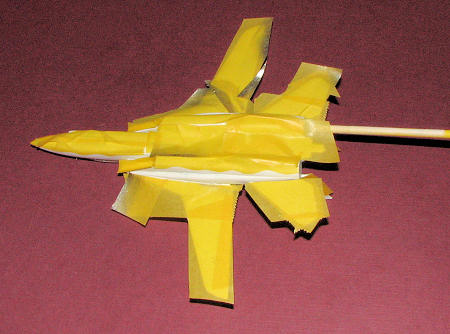 (I was sent an early example that was not sold due to the need to make some changes in the sheet. It should be available soon). So the first thing was to paint it overall white. Once that had dried enough, much masking was done before the FS 16440 gloss light gull grey was painted on. Again, dry time before more masking for the bare metal bits. I used Floquil old silver for this and all during the rest of the painting and decal application, I had to worry about the stuff coming off in my hand. The exhaust area was masked and painted using Alclad II jet exhaust.
(I was sent an early example that was not sold due to the need to make some changes in the sheet. It should be available soon). So the first thing was to paint it overall white. Once that had dried enough, much masking was done before the FS 16440 gloss light gull grey was painted on. Again, dry time before more masking for the bare metal bits. I used Floquil old silver for this and all during the rest of the painting and decal application, I had to worry about the stuff coming off in my hand. The exhaust area was masked and painted using Alclad II jet exhaust.
Then I started applying the decals. FCM has all the decals as separate items. In most cases, this is OK, but when it comes to the data markings around the nose, it might be better off to do these as a set under one carrier as they are quite small. Same goes for the myriad of stencils that I did not use. I also found that these decals are not sized for the LS or Arii kit as in most cases there were times when they were too large or too small. They can be made to fit fairly well, but it is a lot of work and in some cases, like the nose stripe, they need to be trimmed. I also had some trouble using Solvaset as it caused some of the red bits to bleed. I totally trashed several markings due to ham-fisted handling, but fortunately, I was able to rob them from other schemes.
The slime lights came from an ancient Detail & Scale sheet that has seen better days, but is good enough for this project. The last painting was the grey area behind where the wings sweep. This was brush painted dark gull grey before applying the turbine warning stripe. Most people will model the Tomcat with the wings swept back, but most of they actual flying was done with the wings forward for better fuel economy and that is how I modeled this one. Besides, in a dogfight scenario, the wings would automatically sweep out to provide greater lift for tight turning.
| FINAL CONSTRUCTION |
With all the markings in place, I glued on the exhaust cones. These are too small for the mating surface. The tail hook was the l ast bit to be cemented in place. Then the usual touch-up painting. For reference, Humbrol #18 is a very good match for VF-114 orange.
ast bit to be cemented in place. Then the usual touch-up painting. For reference, Humbrol #18 is a very good match for VF-114 orange.
I then bent a section of 3/32 piano wire (try it, it isn't easy) into a slight curve, drilled out the hole in the exhaust to match and drilled a hole to match in a cheap wooden base. This base was painted a nice blue color. The aircraft was cemented in place in an appropriate attitude. I scanned a VF-114 patch, printed it out and attached it to the base using clear gloss paint. Tacky? Perhaps, but it is better than nothing.
| CONCLUSIONS |
OK, lesson learned. The LS kit isn't a really great choice for the early VF-114 scheme where there are lots of bits to fit on fin, stab, and wing tips. For that, use the Revell one. However, despite all those glitches, the overall model isn't that bad and it will make into a nice presentation if one puts a bit of effort into it.
| REFERENCES |
Thanks to me for the insight to buy a couple of these in the 80s. Thanks to FCM for the decals.
If you would like your product reviewed fairly and fairly quickly, please contact the editor or see other details in the